Chainsaw Log Peeler Review
- January 24, 2024
- 1 comment
When it comes to woodworking or log cabin building, having the right tools can significantly streamline your workflow and improve the quality of your work. The Bozeman Chainsaw Log Peeler is one such tool that seems to be a game-changer in the industry. This multitool claims to be the ultimate companion for anyone engaged in woodworking, furniture making, or even just simple firewood cutting. But does it live up to the hype? We took it for a spin, and here’s our detailed review.
Specifications
- Package Dimensions: 10 x 6.7 x 4.2 inches
- Weight: 4.1 lbs
- Item Name: Log Peeler Chainsaw Attachment
- Handle Type: Powder coated
- Material: Cast iron handle, carbide-tipped blade
- For use with: Chainsaws
- Size (inches): 3-1/4
Build and Design
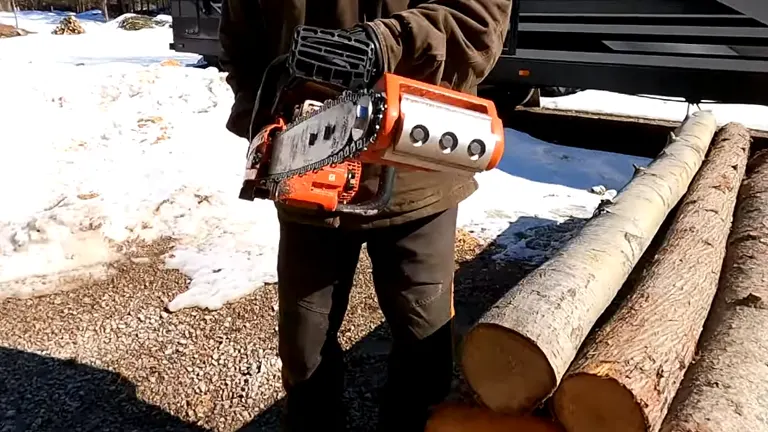
The Chainsaw Log Peeler or Log Wizard Debarking Tool is a robust and well-thought-out tool. It’s made of durable wood material. The item weighs a reasonable 4.1 Pounds, making it relatively easy to handle for most users. The body of the tool is a lightweight cast aluminum, powder-coated for extra durability. It’s designed to attach to the end of your chainsaw, transforming it into a versatile log peeling machine.
Functionality
This Chainsaw attachment is a multitasker. Its primary function is to cut through tree bark and wood smoothly, making it an excellent notch or joint maker. It can also serve as a knot grinder, planner, or post sharpener. One of the standout features is its universal spline/sprocket system, which can accommodate most chain pitches, ensuring compatibility with a wide range of chainsaw tools.

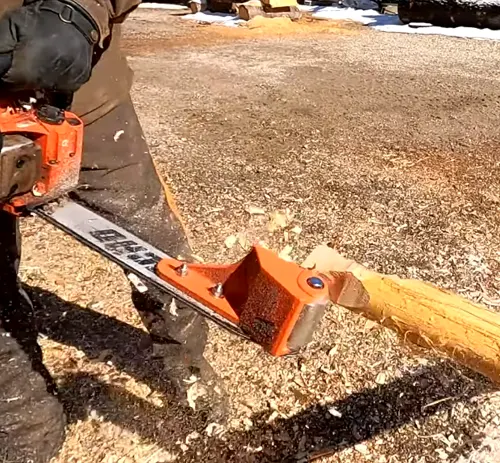
It’s not just about peeling logs; the tool can grind down knots, sharpen poles, and cut channels or grooves in logs, making it a valuable asset for more intricate woodworking projects.
Performance
Performance-wise, the Chainsaw Log Peeler delivers as promised. It comes with two 3 1/4 inch planer blades that are both replaceable and sharp. They can be sharpened or replaced as needed, which is a cost-effective feature. The installation on chainsaw bars is straightforward and takes less than 10 minutes.
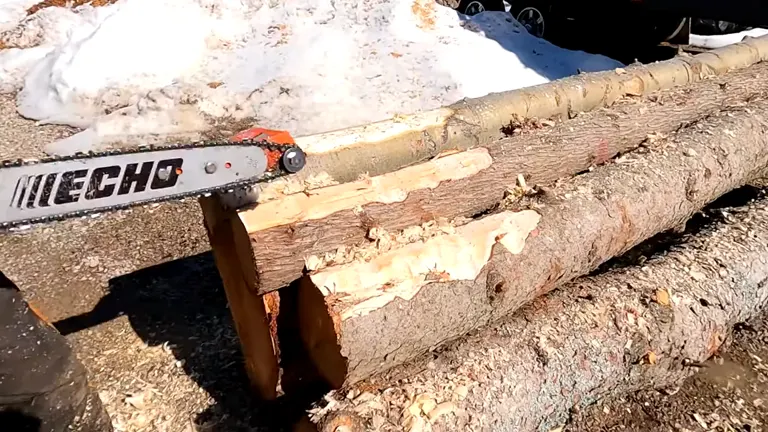
In our test, the log peeler showed remarkable efficiency on various types of logs. From softer woods like poplar, cedar, and spruce to more challenging ones like older pine, sugar maple, and white ash, the tool peeled off the bark cleanly and effectively. The roller drum ensures a smooth operation, while the replaceable tungsten carbide blades cut through the wood with precision.
However, it’s worth noting that the power of your chainsaw can affect the peeler’s performance. While it’s designed for a 65 cc saw, our tests with a 52 cc saw revealed that it might feel slightly underpowered. Nonetheless, with a bit of patience and without forcing it, the tool performs admirably.
Pros and Cons of the Chainsaw Log Peeler/Log Debarker
Pros
- The Log Peeler attachment transforms a standard chainsaw into a multifunctional tool, significantly increasing efficiency in peeling logs and preparing wood for various projects.
- Constructed from lightweight cast aluminum and protected with a durable powder-coated paint, the Log Peeler is built to withstand rigorous use and the harsh conditions of woodworking environments.
- The tool isn’t limited to just debarking; it’s versatile enough to grind down knots, sharpen poles, and cut grooves or channels in logs, making it a multifaceted tool for a wide range of woodworking tasks.
- With a universal sprocket system accommodating various chain sizes and the ability to fit on different chainsaw models, the Log Peeler offers broad compatibility, enhancing its appeal to a wide user base.
- The replaceable tungsten carbide blades are not only durable but can also be easily sharpened or replaced, ensuring the tool remains in top condition with minimal downtime.
Cons
- While the tool is designed for use with a 65 cc saw, it can be operated with a 52 cc saw like the Echo. However, this might lead to underperformance, especially in more demanding tasks, requiring users to work more slowly and carefully.
- The aggressive nature of the blades and the operational technique required might present a learning curve for new users, especially when striving for a smoother finish or tackling different types of wood.
- As with any chainsaw attachment, there’s an inherent risk factor. Users must be vigilant about safety, ensuring the tool is correctly installed, the area is secure, and all safety gear is worn, which might be daunting for some.
- The installation process, while straightforward, does require some time and attention to detail, especially when aligning the attachment, adjusting the chain tension, and ensuring all parts are securely fitted.
- The overall effectiveness of the Log Peeler is partly dependent on the power and condition of the chainsaw it’s attached to. Users with older or less powerful chainsaws might not experience the full potential of the Log Peeler.
Installing the Chainsaw Log Peeler/Log Debarker
If you’re tackling projects involving wood and logs, the Chainsaw Log Peeler, or Log Debarker, is an essential tool to consider. It’s not just a simple attachment; it’s a transformative addition to your chainsaw, enabling you to peel logs effortlessly and prepare them for your projects. Let’s dive into the details of installing and operating this innovative tool.
What You Need
- A compatible chainsaw (Ideally 65 cc, although a 52 cc like the Echo can suffice)
- The Log Peeler/Log Debarker attachment
- A longer chain (e.g., an 18-inch chain for a 16-inch bar)
- Safety equipment: protective gloves, safety glasses, etc.
- Necessary tools for installation (as specified by the manufacturer, often Allen wrenches)
Installation Steps
Preparation
- Ensure your workspace is clean, well-lit, and stable.
- Your chainsaw should be off with the spark plug disconnected to prevent accidental start-ups.
- Put on your safety equipment – better safe than sorry!
Remove the Existing Chainsaw Bar and Chain
- Carefully remove the current bar and chain from your chainsaw, following the manufacturer’s instructions.
Attaching the Log Peeler
- Align the Log Peeler attachment with the chainsaw where the bar used to be.
- The body of the Log Peeler is made of lightweight cast aluminum, typically powder-coated for durability.
- Secure the attachment using the provided fixtures. It should attach to where the bar was, extending your existing chain to accommodate the new length.
Chain and Sprocket Adjustments
- Fit the new, longer chain onto your chainsaw, ensuring it meshes well with the Log Peeler’s sprocket.
- The Log Peeler comes with a universal sprocket system, usually accommodating a 325 or 3/8 sprocket, allowing flexibility depending on your chainsaw model.
Roller Drum and Blades
- The Log Peeler has a roller drum roller to guide the log peeling process, held in place by three bolts.
- Check the two replaceable tungsten carbide blades. They should be sharp and secure. These can be sharpened or replaced as needed, ensuring long-lasting performance.
Final Checks and Safety Measures
- Double-check all connections and fittings. The Log Peeler should be securely attached, and the chain should have appropriate tension, not too tight or too loose.
- Ensure the safety brake is engaged before starting the chainsaw.
Final Thoughts
In summary, the Chainsaw Log Peeler stands out as an exceptional tool for anyone engaged in woodworking or log-related projects. Its robust construction, combined with its versatility and high efficiency, makes it an indispensable addition to your toolkit. The ease of transforming a standard chainsaw into a powerful log peeler, along with the wide array of functionalities it offers, significantly enhances your productivity and the quality of your work.
Whether you’re a seasoned professional seeking to streamline your operations or a passionate hobbyist aiming to elevate your craft, this tool is designed to meet and exceed your expectations. Its durability ensures long-term reliability, making it a smart investment for anyone serious about woodworking.
I definitely recommend the Log Peeler from FORESTER as well. It’s a top-notch log peeler that works efficiently and gets the job done. If you’re in the market for a reliable and effective tool for your woodworking tasks, this one from FORESTER is certainly worth checking out.
FAQs
- Can the Chainsaw Log Peeler/Log Debarker be used on any type of wood?
Yes, the Log Peeler can be used on various types of wood, including both softwoods and hardwoods. However, the efficiency and ease of peeling may vary depending on the wood’s hardness and bark texture. - Is it necessary to have prior experience with chainsaws to use this attachment effectively?
While prior experience with chainsaws is beneficial, it’s not strictly necessary. The Log Peeler is designed for straightforward operation. However, beginners should ensure they understand both the chainsaw’s and the attachment’s operation manuals and adhere strictly to safety guidelines. - How often do the tungsten carbide blades need to be replaced or sharpened?
The lifespan of the blades depends on usage frequency and the type of wood you’re working with. Regularly inspect the blades for wear and sharpness. While tungsten carbide blades are known for their durability, sharpening or replacing them as needed will ensure consistent performance. - Can the Chainsaw Log Peeler/Log Debarker be used for commercial purposes, or is it only suitable for home use?
The Chainsaw Log Peeler/Log Debarker is versatile enough to be used for both home projects and commercial purposes. Its robust construction and efficiency make it suitable for frequent, professional use, as well as occasional, home-based projects. - What safety equipment is recommended when using the Chainsaw Log Peeler/Log Debarker?
It is recommended to wear safety goggles, gloves, ear protection, and sturdy work boots when using the Chainsaw Log Peeler. Ensuring that you’re well-protected reduces the risk of injury from flying debris or accidental slips. - How does the weight of the Chainsaw Log Peeler/Log Debarker affect the handling of the chainsaw?
The Chainsaw Log Peeler is designed with lightweight cast aluminum, minimizing the addition of weight and balancing the chainsaw’s handling. Users should still exercise control and take breaks as needed, especially during extended periods of use. - Can the Chainsaw Log Peeler/Log Debarker be used in wet conditions or on damp wood?
While the Chainsaw Log Peeler can technically be used on damp wood, it’s advisable to use it in dry conditions for optimal performance and safety. Wet conditions can make handling the chainsaw more challenging and may affect the tool’s efficiency and the longevity of its components. - What is the procedure for adjusting the depth of the peel or the thickness of the bark removed?
The depth of the peel can usually be adjusted by changing the pressure you apply and the angle at which you hold the chainsaw with the Log Peeler attached. It’s recommended to start with a shallow peel and gradually adjust as you become more accustomed to the tool’s operation.
Join the discussion below by sharing your experiences, tips, or reviews. Your contributions help others make informed decisions and navigate their chainsaw choices with confidence. Let’s build a community of shared knowledge for all wood-cutting enthusiasts!

David Murray
Forestry AuthorI'm David Murry, a forestry equipment specialist with a focus on chainsaw operation. With over 13 years of experience, I've honed my skills in operating and maintaining a wide range of machinery, from chainsaws to log splitters. My passion for the outdoors and commitment to sustainable forestry drive my work, which emphasizes safety, efficiency, and staying updated with industry advancements. Additionally, I'm dedicated to sharing my expertise and promoting environmental awareness within the forestry community.

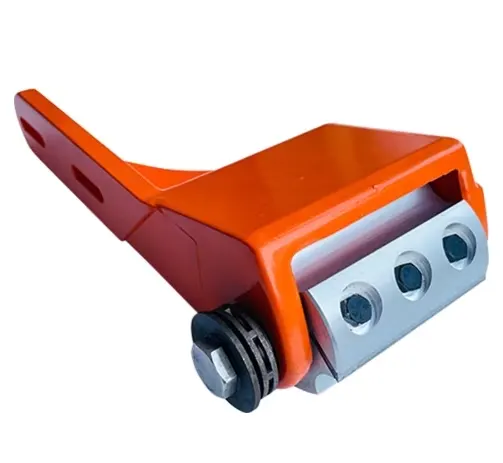
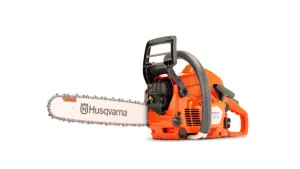
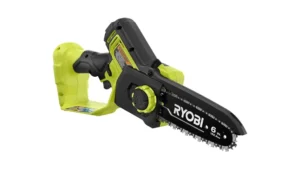
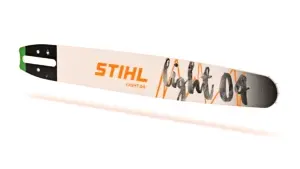
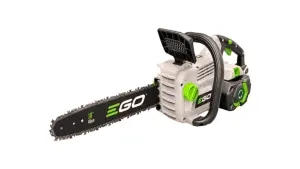
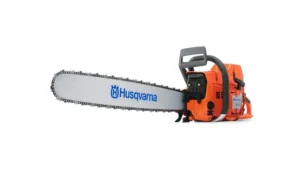
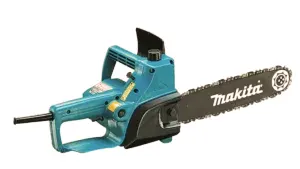
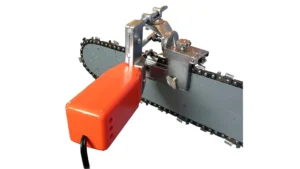

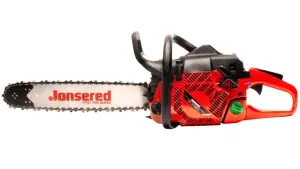

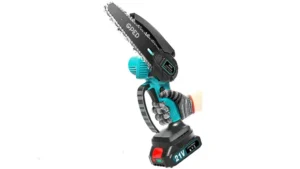

What a great review! It was really helpful in deciding whether to move forward with purchasing one of these log peelers. Thanks you!
Johannes Walker
March 19, 2024 4:27 am